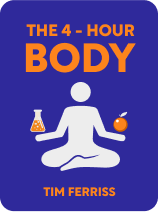

This article is an excerpt from the Shortform book guide to "The 4-Hour Body" by Timothy Ferriss. Shortform has the world's best summaries and analyses of books you should be reading.
Like this article? Sign up for a free trial here .
What is The Four-Hour Body? What topics does Tim Ferriss cover in The Four-Hour Body?
The Four-Hour Body is a book by Tim Ferriss focused on changing your body and improving its performance. He covers six areas of performance in the book.
Read on for the six areas covered in The Four-Hour Body.
Overview of The Four-Hour Body
The Four-Hour Body is an experimental lifestyle with the goal of finding out what makes your body work best. Self-experimentation has several benefits over conventional science—it’s personalized, fast-paced, multi-disciplinary, and free from corporate agenda.
Author Tim Ferriss has been living this lifestyle for years, and in The Four-Hour Body, he shares what he’s learned about his own body from researching scientific literature, interviewing experts, and self-experimentation. The book’s title comes from a 28-day experiment in which he spent only four hours total in the gym but lost 3 pounds of fat, gained 34 pounds of muscle, and decreased his total cholesterol.
Ferriss covers six topics in The Four Hour Body:
- Body recomposition (changing the percentages of your body that are made up of muscle vs. fat)
- Enhancing sex
- Improving sleep
- Preventing and recovering from injuries
- Improving sports-specific skills
- Living longer
While everyone’s body is different, much of what the author discovered is broadly applicable to most people, so you can use his recommendations as a starting point and inspiration for your own self-experimentation.
(Shortform note: We recommend consulting your doctor before starting any of the book’s programs or self-experimenting.)
Minimum Effective Dose
An important part of your experimentation will be to find the minimum effective dose (MED), which is the smallest dose that will create a particular result. For example, the MED to boil water is 212 degrees Fahrenheit. Heating water past 212 degrees doesn’t make it any more boiled. Don’t ever exceed the MED required for any program—you’ll waste your time and increase your risk of injury.
Sticking to an Experiment or Program Like The Four-Hour Body
To successfully carry out an experiment or stick to a program, you need to change your lifestyle, which can be hard. Fortunately, there are some strategies in The Four-Hour Body:
- Force an epiphany. Don’t just wish for change, think of it as necessary.
- Measure a variable. This will prove to you that all your work is having an effect.
- Oversimplify. Measuring variables is a lot of work, so estimate instead of taking exact measurements to make tracking more manageable.
- Accept halfway completion. Even if you can’t finish something, or you can’t do it perfectly, you’ll still get some benefit from having done part of it.
- Be aware of your behavior as it happens. You can only change something before it’s happened. For example, reflect on what you’re eating before you eat it.
- Harness the power of competition. Make the program into a goal or bet to motivate yourself.
- Don’t try to change multiple lifestyle factors all at the same time. For example, if you don’t cook, buy frozen or canned food while dieting.
Topic #1: Body Recomposition
Body composition is a measure of how much of the body is made up of fat vs. muscle. To change your body composition, known as “recomp,” you need to lose fat, gain muscle, or both. You’ll achieve this using diet, exercise, supplements, and temperature manipulation.
Topic #2: Enhancing Sex
The second of the six topics the author covers in the 4HB is how to improve your sex life. In this section, we’ll first look at women’s sex lives, focusing on orgasms. Then, we’ll look at men, focusing on testosterone and sperm count.
Topic #3: Improving Sleep
There are several techniques for improving your sleep:
- Have a ten-minute ice bath an hour before going to bed. Cold signals the body that it’s time for sleep.
- Exercise more during the day. Exercise, in general, helps you fall asleep, and the author got the best results with injury prevention stabilization exercises (see Chapter 12 of the full summary).
- Take 200 micrograms of Huperzine-A half an hour before bed, a maximum of three days a week to get more REM sleep.
- Take California poppy extract (15 or more drops) and don’t drink more than two glasses of wine before bed. This will improve your physical performance the next day.
- Eat before bed if you find yourself sleeping 8-10 hours and still waking up tired. Probably, your blood sugar is low.
- Use sleep-improving gadgets such as a humidifier, NightWave, blue light emitter, and smart alarms.
- Sleep in a position that’s difficult to fidget from, such as on your stomach with your limbs spread out. When you can’t fidget, you fall asleep faster.
- Sleep for longer than nine hours or wake up for five minutes after four and a half hours of sleep. This will increase the ratio of REM (rapid eye movement sleep, which consolidates memory) to total sleep. The ratio is important for sleep quality.
Topic #4: Preventing and Recovering From Injuries
The best way to manage injury is “prehab,” which is the opposite of rehab—instead of doing recovery exercises after you’ve been injured, you do exercises in advance of working out to stabilize your body so you don’t become injured in the first place.
Topic #5: Improving Sports-Specific Skills
No matter what sport you play, it’s helpful to be strong, because being stronger than someone else of equal skill gives you an advantage over them.
When strength training to aid athletic performance, keep the following principles in mind:
- Strength training should never interfere with the practice of your sport. Train your sport-specific skills six days a week, do sports-related training (such as conditioning) three days a week, and do strength training three days a week (on the days you’re not doing sports-related training).
- Sets should only contain two or three reps. Total reps should number around 10, whether that’s five sets of two or three sets of three.
- Do only a few exercises that, ideally, target most of the bodies’ muscle groups, such as the bench press, deadlift, or Janda sit-up.
- Spend five minutes resting in between all sets.
- Don’t push to failure (being so fatigued you can’t do any more reps).
- You should feel stronger after strength training than when you started.
Topic #6: Living Longer
The author recommends the following four strategies for living longer, all of which are low-cost, low-risk, and low-misery:
- Taking creatine monohydrate, which helps prevent or mitigate the development of Huntington’s, Alzheimer’s, and Parkinson’s diseases.
- Intermittent fasting (alternate periods of fasting with periods of eating normally). Restricting calories extends lifespan because when the body is missing essential chemicals, it triggers autophagy, which is the process of clearing out cells of old, built-up proteins. These old proteins contribute to aging.
- Protein cycling. Protein cycling is a more specific form of caloric restriction. One day a week, only eat food that’s made up of no more than 5% protein.
- Get rid of excess iron. Iron is a building block of free radicals, molecules that contribute to aging, and studies have shown that high concentrations of iron are related to heart attacks. To get rid of excess iron, which is stored in blood, simply donate blood.

———End of Preview———
Like what you just read? Read the rest of the world's best book summary and analysis of Timothy Ferriss's "The 4-Hour Body" at Shortform .
Here's what you'll find in our full The 4-Hour Body summary :
- How to do the least amount you need to do for the results you want
- Why you need a cheat day in your diet
- How to improve everything about your body, including sleep, sex, and longevity






